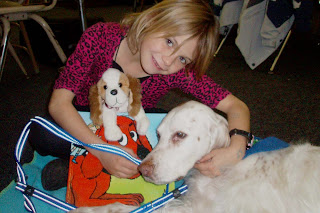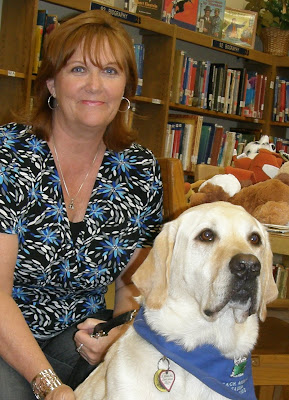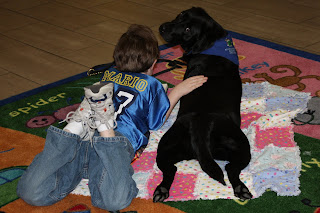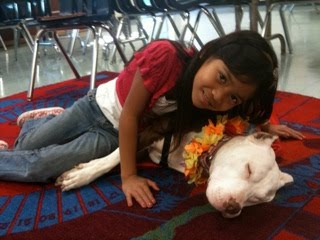One of the most hard-working and inspiring figures in Los Angeles animal rescue is Josie Gavieres. When DDR needed assistance with pulling dogs from the 61st Street Kennels, Lori knew that Josie would be one of the instrumental go-to people that needed to be involved.That’s only one of many projects that Josie has assisted DDR with. She is also the founder of the project B.A.R.K. (Beach Animals Reading with Kids)which has garnered much deserved recognition and accolades from the community that have included, schools, teachers, administrators, parents and especially the children that have participated in this reading program.
DDR is very proud to spotlight the BARK Reading Program and if you are interested in taking part, volunteering or sponsoring the great work that BARK does, please contact Josie at barkreadingdogs@aol.com
B.A.R.K. Founder Josie Gavieres and Groucho
WHAT IS BARK?
BARK is a program where elementary school children read out loud to dogs on a one-on-one basis to increase their reading skills and self-confidence. Reading out loud is crucial to learning because if you read to yourself, you’ll skip the words you don’t know. However, many kids find it intimidating to read in front of the classroom. That’s where BARK comes in.
Many of the children picked to read to our dogs are at a low reading level, have low self-confidence, or have an unstable home life. All the kids want to read to the dog so just being picked for the program immediately makes the student feel better. The dogs is a calm, non-judgmental soft friend who does not laugh when the child makes a mistake. Even learning questions are based through the dog, “Princess, do you understand that word? It means…” Children read to the BARK dog 15 minutes, once per week for eight weeks. At the end of that time, they are given a bookmark with information about their BARK dog, a small stuffed dog, and a brand new book.
With the reading dogs, we have seen some kids improve up to two reading levels over eight weeks; we have shy, withdrawn kids come out of their shells, and we have seen kids catch up in all of their studies because they can now read their other lessons.
HOW BARK STARTED
My son, Chris, and I raised six puppies for Guide Dogs for the Blind and Groucho, the last dog, was career-changed and came home to live with me. Because of his temperament, I had him certified as a therapy dog. While looking on the internet for places to take him, I found a reading program in Utah, but none in Southern California. I figured this was something I could figure out so I contacted nine schools, without success. Finally the 10th school said, “Yes.” In October 2007, BARK officially began with four dogs at Bryant Elementary .
Within two months, schools started to hear about BARK and other dogs wanted to join. By March 2008, we had nine dogs in five schools. Reading dog programs began to get media coverage in other areas and more schools and dogs joined. By February 2009, we had 20 dogs and, at this point, we have 54 dogs listening to kids in 35 schools and two libraries. We also do one-time visits at many schools.
We match the dogs to a school in their neighborhood so they don’t have to drive across town. If a school asks for a one-time visit, we ask all the dogs that are available (hopefully not too far away).
BARK dogs are big and small, from Chihuahuas and Frenchies to Pit Bulls, Rotties, a Newfy, and a Leonberger. The dogs are all a credit to their particular breed. Many of our kids are in low-income neighborhoods and all they know are dogs who charge fences, bite, and snarl. Rowdy, a pit bull handled by Linda Bates, was recently retired after 14 years of therapy service!
Unless a principal or counselor asks about the type of dog, we send a local dog to the school a few days before their first official visit. Sometimes the school can be a bit surprised if the dog is a bit bigger than they anticipated, but they soon realize that no matter the breed of dog, they’re sweet and loving and won’t hurt the kids.
Most handlers tell us that within the first few weeks of going to a school, the dog learns when they’re making that last turn to the school. Their nose starts wiggling and they stand up and start wagging their tails. They know they’re going to be the center of attention and get lots of love for the next hour!
What major challenge have you come across running BARK that you have been able to overcome? What challenges remain?
Our first challenge was getting the first school to accept us.
Now our main challenge is not having enough dogs to cover the schools that request BARK dogs.
What other projects would you like to launch under BARK? Future plans?
-BARK has just started working with deaf children. The child reads the word and signs to their interpreter who then speaks the word. It’s been a huge success and we would love to expand this program to more schools with deaf children.
-BARK was recently contacted about having a cat join and, once she is certified, we will be starting a “reading to the cats” program (no name for this program just yet).
-We need to teach the new generations about spay/neuter. Groucho and I put on fun therapy/service dog/humane education presentations at elementary schools. One day, I would love to say, “and the free mobile spay/neuter clinic will be in the parking lot this Saturday.” The kids will learn and encourage their parents to bring their dogs.
I’ve come to believe that any successful Rescue related work takes “a village,” any folks or organizations you would like to thank for getting BARK running and going?
-Ms. Robinson from Bryant Elementary who said and continues to say, “Yes, I see the value of this program for my students.”
-My aunt and uncle, Joanne and Ralph Bellenot, who have scoured the valley’s flea markets and garage sales every weekend for the past 2-1/2 years for stuffed dogs and beanie babies to give to the kids at the end of their reading sessions. The kids just light up when given these little dogs!
-Most importantly, I appreciate every one of my BARK members who not only reliably volunteer their time and dogs to help listen to the kids, but who invested the time and training to have exceptional, friendly, and well-behaved dogs. They are the only reason the program is growing.
How did you and BARK come into the fold of Downtown Dog Rescue?
I honestly can’t remember who told me about Lori putting on a free mobile spay/neuter clinic in Compton back in 2006, but I showed up with four friends. It was obvious how much the community wanted to fix their dogs and this program was enabling them to do so. I’ve helped with several volunteer organizations, but am committed to Lori because of her courage to deal with things others won’t, be creative in getting new programs started, and following through with what she says she is going to do. Recently, my son (and his friends) and I have been cleaning and feeding at the 61st Street kennels and helping with transports when rescues are found to take the dogs.
How can PITStop readers help BARK continue the great work you do? Are there volunteering opportunities available?
BARK supplies each handler team with all supplies needed. Therefore, we can always use donations of these supplies (carry-on rolling suitcases, books about dogs, dog stickers). We welcome all dogs with good temperaments to join BARK. You do not have to commit to a full eight-week session. We have BARK members who work or have busy schedules and are on a “special events” list. We walked in a Christmas parade last year and gave out 750 books, we will have a booth at the OC Pet Expo in April, and we’re getting requests for dogs to attend events other than listening to kids.

CONTACT
Website: READING DOGS.ORG
Email: barkreadingdogs@aol.com
Phone: (562)235-8835
VIDEO OF BARK IN ACTION
JOSIE GAVIERES HONORED



